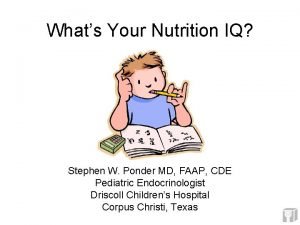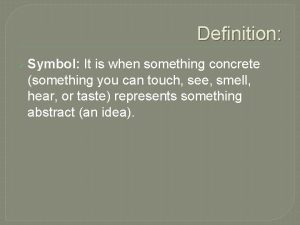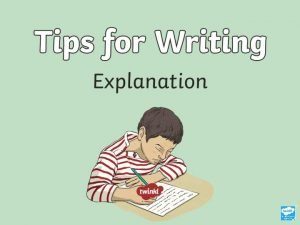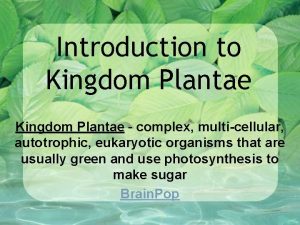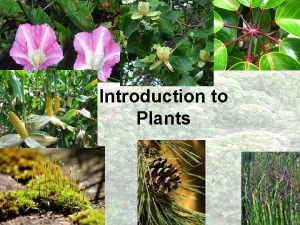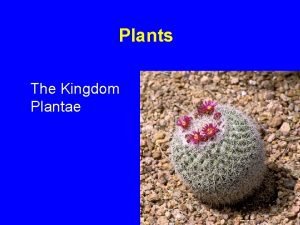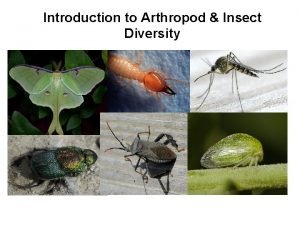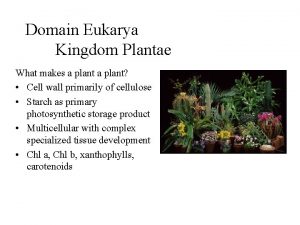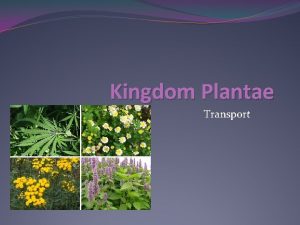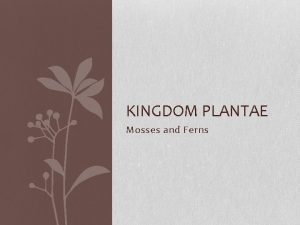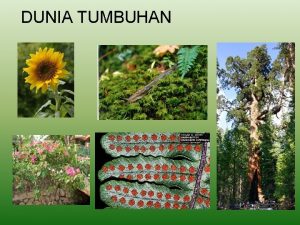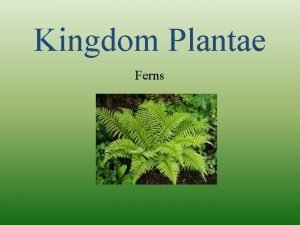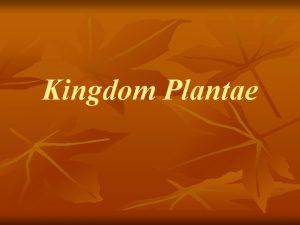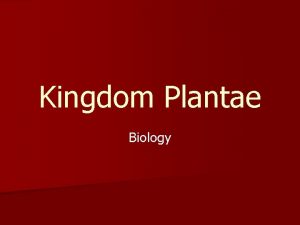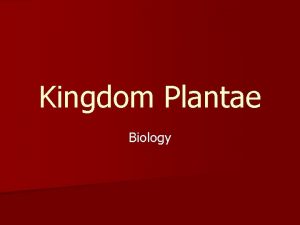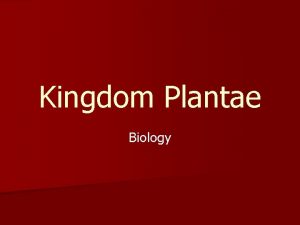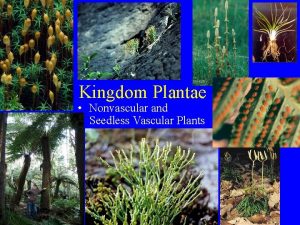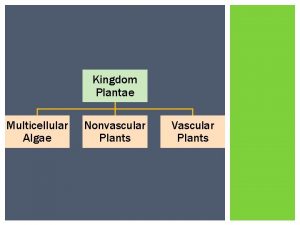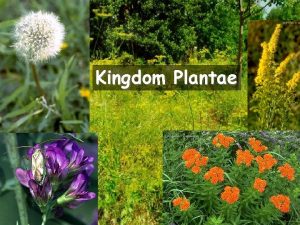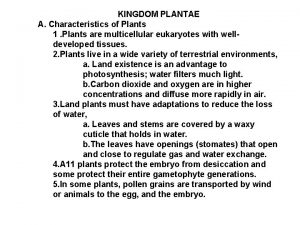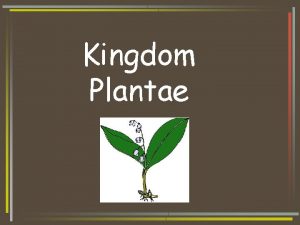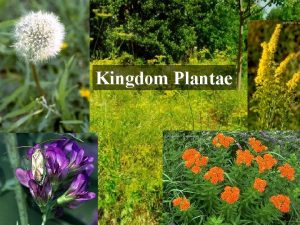KINGDOM PLANTAE KINGDOM PLANTAE Something to ponder Plants




































- Slides: 36

KINGDOM PLANTAE

KINGDOM PLANTAE Something to ponder: – Plants are not boring. Plants have devised fabulous mechanisms for sustaining and supporting themselves. – Plants may not be able to move, but in their own way, they have figured out ways to do many things better than animals – evolved different strategies. – What is an animal really doing when it eats an apple? It is the ultimate bribe – tricking the animal to eat something delicious so that the animal will spread its seeds over great distances.

KINGDOM PLANTAE 3 • Cell wall - composed of cellulose • Eukaryotes • Autotrophic • Absorb sunlight to make glucose – Photosynthesis • Multicellular

KINGDOM PLANTAE 4 Domains EUKARYA Kingdoms PLANT Cell Type – Prokaryote or Eukaryote EUKARYOTE # of cells – Unicellular or Multicellular or Both MULTICELLULAR Cell Structure – Cell wall composition CELL WALL MADE WITH CELLULOSE Nutrition – Autotroph or Heterotroph or Both AUTOTROPHS

PLANTS VERSUS ALGAE Green algae is believed to be the ancestors of plants. ALGAE PLANTS – unicellular, colonial, or multi-cellular. – Multicellular – Eukaryotic photosynthesizers – Parts: holdfasts, stapes and blades – Roots, stems, leaves, flowers, fruits, seeds, cones – Cell wall made of cellulose – Each algae cell must obtain its own nutrients from water for survival. – Some algae cannot move, others float in the water – Cell wall made of cellulose – Has vascular systems to transport water and nutrients – Cannot move, rooted to ground

TO DO – Watch Tree and Plant Life in the Jungle

SURVIVAL NEEDS – Sunlight – Gas exchange – Water and minerals – Movement of water and nutrients

PLANT ADAPTATIONS

DEFINITION OF ADAPTATION – The adjustment or changes in behavior, physiology, and structure of an organism to become more suited to an environment. – It is derived form the Latin word “adaptare” which mean “to fit”.

PLANT ADAPTATIONS – Plants have adaptations to help them live and grow in different areas. – These adaptations make it very difficult for the plant to survive in a different area. – This is why plants are found in one area, but not in another. – For example, you wouldn’t see a cactus living in the Arctic. Nor would you see lots of really tall trees growing in the grasslands.

WHY DO PLANTS ADAPT? – For climate/location – to get the necessary resources – To reduce water loss – For reproduction – To defend themselves

ATTAINMENT OF RESOURCES – Evolutionary trend was to move from water to land, so plants had to adapt – Land plants evolved methods to gain vital minerals from the soil. – Green algae absorb nutrients they need directly from the water they live in. – Land plants have to live without being suspended in water.

ATTAINMENT OF RESOURCES – Roots developed as a structure that allowed plants to obtain minerals and water from the soil.

ATTAINMENT OF RESOURCES – Some plants developed vascular tissue (xylem and phloem) that act as a transport system to bring water and other substances such as minerals up the plant body, allowing for increased plant size.

ATTAINMENT OF RESOURCES – All plants contain lignin which binds to cellulose fibers to harden and strengthen the cell walls of plants to support growth.

ATTAINMENT OF RESOURCES – Stems developed to store and transport water & nutrients. – Leaves are modified to maximize photosynthesis.

TO DO – How the Quiver tree survives in the desert

ADAPTATIONS – To reduce water loss – Reproduction

WATER LOSS – Strategies to catch and retain water were vital for the survival of land plants. – Once removed from moist, swampy areas, plants risk desiccation, or drying out. – Desiccation means to dry out due to a lack of water.

WATER LOSS – To prevent desiccation, many plants developed a cuticle (a thick, waxy, watertight barrier) that covers the plant and prevents loss of moisture to the air.

WATER LOSS – The stomata are openings in the cuticle that allow for gas exchange and transpiration of water as the plant photosynthesis.

WATER LOSS There are several regions of the Earth that plants have had to adapt to: – Deserts – Grasslands – Taiga – Tropical Rain Forest

WATER LOSS - DESERT – Plants called SUCCULENTS store water in their stems and leaves. – Some plants have no leaves or leaves that only grow after it rains. Leafless green plants conduct photosynthesis in their green stems. – Long roots spread out wide or go deep into the ground to absorb water. – Leaves with hair help shade the plant, reducing water loss. – Some leaves turn during the day to expose a minimum surface area to the heat. – Grow slowly – uses less water.

WATER LOSS - GRASSLAND – Roots extend deep into the ground to absorb as much moisture as they can. – Prairie grasses have narrow leaves which slow water loss.

WATER LOSS - TAIGA – Many trees have needle-like leaves whose shape reduced water loss – Waxy coating on leaves prevents evaporation

WATER LOSS – TROPICAL RAIN FOREST – Here there can be too much water! – Drip tips and waxy surfaces allow water to run off to discourage growth of bacteria and fungi. – Smooth bark or waxy flowers speed the run-off of water. – Many bromeliads are epiphytes (plant that live on other plants). Instead of collecting water with roots, they collect water in a central reservoir from which they absorb the water. – Epiphytic orchids have aerial roots that cling to the host plant, absorbs minerals, and absorb water from the air.

TO DO Plant Structure and Adaptations

REPRODUCTION – The reproductive processes of the earliest plants to evolve from green algae still required an aquatic environment. – Consequently, these primitive land plants could live only in highly moist, swampy areas. – Plants evolved the ability to reproduce without water and began to populate drier environments.

REPRODUCTION – The seed allowed safe dispersal of plant embryos by supplying it with nutrition and protection against hostile conditions. Seeds can remain dormant during unfavorable conditions.

REPRODUCTION – Pollen grains containing the male gamete could be dispersed without water.

REPRODUCTION – Flowers developed to attract pollinators and allow for greater dispersal of the pollen.

REPRODUCTION – Fruits developed to protect the embryo and allow for greater dispersal of the plant.

TO DO – Watch: Adaption to Extremes

PLANT DEFENSES – Mechanical defense - incorporated into the physical structure of the organism. – thorns, spines and stiff hairs that repel a predator

PLANT DEFENSES – Chemical defense - occurs when the plant produces stinging sensations, paralysis, poisoning, or just a bad taste. – Chemical Defense

PLANT DEFENSES – Camouflage - the organism blends into its environment or appear to be something they are not Pebble Plant Lithops
 Cool protists
Cool protists What do kingdom fungi and kingdom plantae share
What do kingdom fungi and kingdom plantae share Protista domain
Protista domain Nnn ruled
Nnn ruled Youtube
Youtube Capital of egypt during the old kingdom
Capital of egypt during the old kingdom Old kingdom middle kingdom new kingdom
Old kingdom middle kingdom new kingdom Jaroslaw ponder
Jaroslaw ponder Dr ponder endocrinologist
Dr ponder endocrinologist Louie blake sarmiento
Louie blake sarmiento Quote to ponder
Quote to ponder Point to ponder example
Point to ponder example A thought to ponder math
A thought to ponder math Statements to ponder
Statements to ponder Ponder in research
Ponder in research What does concrete symbolize
What does concrete symbolize The purpose of explanation
The purpose of explanation Symbol/symbolism definition
Symbol/symbolism definition Smart is not something you are
Smart is not something you are Something old something new poem
Something old something new poem The wind yells while blowing
The wind yells while blowing Something that describes something
Something that describes something Concrete symbols
Concrete symbols Plantae multicellular
Plantae multicellular Lycodiophyta
Lycodiophyta Plantae characteristics
Plantae characteristics Cladogram kingdoms
Cladogram kingdoms Biology
Biology Common characteristics of plantae
Common characteristics of plantae Introduction of kingdom plantae
Introduction of kingdom plantae Kingdom plantae chart
Kingdom plantae chart Coconut embryo
Coconut embryo Archaebacteria characteristics
Archaebacteria characteristics How does plantae get nutrients
How does plantae get nutrients Subkingdom of kingdom plantae
Subkingdom of kingdom plantae Disadvantages of coniferophyta
Disadvantages of coniferophyta Siklus lumut
Siklus lumut








